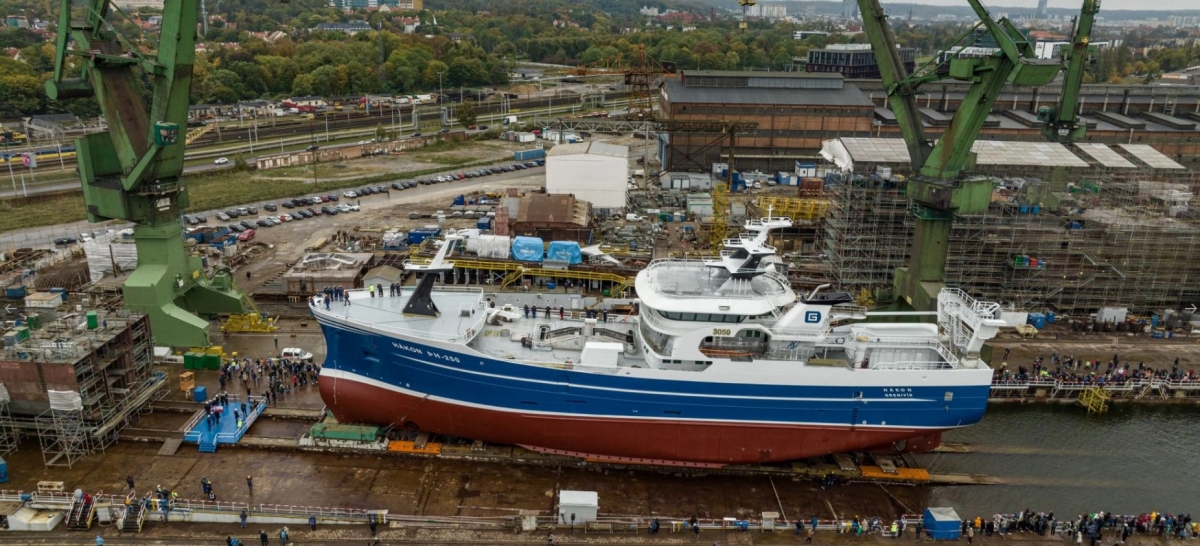
On Friday, October 20, a large audience gathered at the iconic shipyard grounds with green cranes in Gdańsk witnessed an important event - a ship was launched from the slipway again, after many years. This time it was done by Karstensen Shipyard Poland, which has owned the site for several months and is building fishing vessels there.
Despite the cold weather, several hundred people showed up at the slipway, including many families with children. Even in Gdansk, a thriving shipbuilding center, residents rarely have the opportunity to attend such events.
Punctually at 2pm, Karstensen Shipyard Poland director Tomasz Mulica appeared on stage. He spoke in a few words about the importance of the event itself for him and the company he manages - for here, after years, shipbuilding returned to the traditionally shipbuilding areas in Gdansk, and today's launching open to the public was the best proof of this. He also described the ship itself a bit. Standing in front of him on the longitudinal slipway was the 75-meter Hákon, a trawler being built for a shipowner from Iceland. Its tonnage capacity is about 2,900 tons. The vessel is powered by a Wartsila 8V31 main engine, which will allow her to reach a speed of about 16 knots. Fifteen people will work on her.
The shipyard director was followed by a representative of the shipowner, Gjögur HF, who thanked both the shipyard and the entire Karstensen Group for their cooperation, and revealed that the vessel bears a traditional name for the company - it is the fifth ship in a row to bear the name Hákon.
Then we heard the anthems of Iceland and Poland, and then it was time for what everyone had been waiting for - Paweł Porała, the shipyard's production manager, gave the appropriate instructions, and the security under the ship was released. This one still stood motionless on the slipway for several dozen seconds, which certainly caused an accelerated heartbeat in those gathered, after which it majestically slid down the stern into the water, where a moment later it was intercepted by tugs waiting nearby. The operation was a hundred percent successful.
"There were emotions, while we were prepared. Of course, we knew that we did everything we could to prepare well. Nevertheless, emotions are always there, so we are glad that everything worked out as we planned," Tomasz Mulica, director of the shipyard, commented hotly. He added that from the beginning after the move to Gdańsk, Karstensen's goal was to restore the traditionally shipbuilding areas to their productive function. He also announced that this was not the last launch the public could admire.
Hákon was not the first ship launched by Karstensen in Gdansk, but it was the first to be launched using a longitudinal slipway. The previous launching was done using a sunken dock.
"The main difference is that with this launching we have that moment from which we have no control over the ship. It is those few seconds when we release the stopwatches, the hull begins to move down the slipway and then there is no longer any possibility to correct any error. Therefore, a great deal of attention has to be paid to preparing the hull, preparing the substructure, and especially this part, it was something new for us," explained director Tomasz Mulica. The experience of shipbuilders working at Karstensen proved invaluable. - Nauta shipyard built more than 20 hulls for us on this facility between 2013 and 2018, and of course they were launched in exactly the same way, while at that time we did not pay attention to this element. Of course, we were present at it, we were in charge of the hull, we were also in charge of receiving it, while we took part in the launching as guests. This perspective is completely different - being a guest at the launching versus being responsible for the launching," recalls Director Mulica.
Hákon is being built for the Icelandic company Gjögur. Karstensen Shipyard used the services of other Polish companies when working on the vessel, for example, windows and portholes for the ship were supplied by KSP Promap. In total, there were 28 windows for the wheelhouse, 37 cabin windows and 6 portholes with thermal insulation glass, including laminated and electroglazing, with a total weight of 5 tons. According to Przemyslaw Hoffman, director of Promap, the installation of the windows themselves, which were also the responsibility of the company's employees, was completed in 4 days, which was possible thanks to the support and assistance of Karstensen shipyard employees.
Interestingly, Karstensen will begin construction of another twin vessel, with construction number 480, in a few months.
"This is our main, so to speak, type of vessel that we build - RSW trawlers for catching live fish. This particular one has the ability to fish with a trawl and also with a net, the so-called purse seine. These are very modern vessels, very carefully designed in terms of their economy, in terms of the comfort of the crew, all the equipment they have. This is our flagship product," praises Tomasz Mulica.


